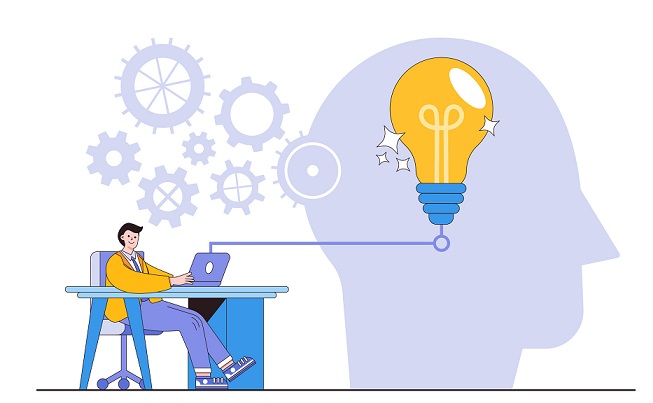
Meet Anna. Anna just joined a B2B SaaS firm as a content specialist and is in charge of streamlining the company's content production. But, when she rolls her sleeves up and starts digging into the process, she quickly realizes it’s a mess. She has to chase down different employees to source information, there’s so much duplicate content that it’s hard to find the right piece.
Anna's not alone—a study highlighted that employees spend 50% of their workday searching for relevant information. As a result, burnout, high turnover, and low productivity are just three issues scraping away at the company's bottom line due to this inefficiency.
The solution? Knowledge management.
Knowledge management (KM) is more than just a fancy buzzword that rolls off the tongue. It's an organized, proactive approach to capture, store and distribute information and data within an organization. In this article, we cover what a knowledge management framework is, how to build one, and why it's important for your business.
What is a Knowledge Management Framework?
A knowledge management framework is a system that streamlines the way an organization manages, creates, and distributes its knowledge. This framework contains a mix of technologies, roles, processes, and strategy/governance that enable knowledge acquisition, sharing, maintenance, and re-use.
There are three types of knowledge an organization needs to manage:
- Explicit knowledge—structured data and information that employees can easily share, such as how-to guides, brand bibles, emails, and customer service protocols.
- Tacit knowledge—less tangible information accumulated over time through personal experience and intuition, such as the know-how of experienced employees or insights from customer feedback.
- Contextual knowledge—information related to specific situations, such as customer data associated with a purchase.
Do you Need a Knowledge Management Framework: Must-Have or Nice-to-Have?
A knowledge management framework retains valuable internal and external knowledge that's still there even when employees leave the organization. This framework also gets employees up to speed quickly, as they don't have to trawl through emails to find the right information—it's all in one place.
The lack of a structure results in frustrated employees—research shows that employees who can't access the information they need waste around 4 hours every day searching for relevant information. A knowledge management framework creates a single source of truth, especially during onboarding, to ensure new employees have easy access to relevant company resources.
Epic Engineering, for example, saved 40 hours per employee during onboarding. A centralized location for all training videos, how-to-articles, and company standards gave a searchable way for employees to get up to speed.
External knowledge bases also give customers the resources to resolve their issues. Customers want to resolve their problems quickly, and self-service support channels like these knowledge bases help them answer common questions with canned answers and how-to-videos.
Hack the Box, for example, reduced customer churn by 20% by creating a well-documented platform with Helpjuice. These customers resolved simple or complex problems themselves, reducing the burden on the technical support team.
A knowledge base empowers customers and employees to find answers independently and is a reference point for best practices and company standards.
Pillars of a Successful Knowledge Management Framework
Building an effective knowledge management framework takes more than just a few guidelines. Here are five essential pillars of a knowledge management framework:
1. People
Establishing a knowledge management framework isn't a one-department job. It requires alignment from top to bottom and across all departments and teams to be successful. Identify champions from each department who can help identify, capture and share knowledge.
Involve senior leaders from the beginning and keep them up to date with progress. Departments such as HR, customer service, sales, marketing, and operations gain the most from a comprehensive knowledge management framework. Involve key advocates from these departments to promote buy-in and create a culture of collaboration.
Ensure your knowledge management framework is kept up to date. Create a process to update your system in real-time. Assign responsibility to each team or department to keep their information up-to-date. Include a way for employees to review and assess the accuracy of data. For example, you might include a feedback form for employees to rate the accuracy and usability of their knowledge resources.
Apart from this, include a governance system that keeps the framework in check. Establish roles and responsibilities, create KPIs, and set clear objectives to keep on track.
2. Process
Define every process that dictates how employees access, collect, store, and share knowledge. Clear guidelines such as who can access what type of information, when to update data, and how to record new insights ensure teams don't miss critical information and have the right knowledge when needed.
First, delineate what kind of organizational knowledge is most important. Is it customer data, market trends, financial information, or something else? What formats should this knowledge be stored in, and where should it be saved? Create a content governance policy to establish who manages the data and ensure all teams are on the same page regarding security measures.
Then, define the workflow for capturing knowledge. How will you keep track of knowledge? What tools do you need to store and share information? Use workflow tools like Trello or Asana to assign tasks, track progress, and set deadlines.
Finally, create a feedback loop so employees can guide content accuracy and relevance. This ensures the knowledge management framework is always up-to-date and provides the most value.
Create a centralized knowledge management repository to collect and store new insights. This repository should be accessible from anywhere and is organized intuitively so employees can easily find what they need.
3. Strategy
Implement a strategy that drives knowledge management efforts and explains how the system works. A clear, documented strategy ensures everyone is on the same page and actively contributing to knowledge management. It should reflect company values, objectives, priorities, and existing industry trends or regulations that could influence your framework.
Ensure the strategy highlights the value proposition of the framework, how it'll benefit the organization, and which processes or tools need to be in place. It should also explain how the framework will improve customer service and sales, support product innovation, or streamline internal processes. Stress why employee contribution is important and how they can help maintain an effective knowledge management framework. Lastly, establish KPIs for each department or team that indicate how well the knowledge management framework is used.
Understand your organization’s current state when it comes to knowledge management. Assess where you stand in capturing, sharing, and utilizing data—what works, what doesn’t, and where to improve. Create a roadmap that outlines the steps necessary to get from ‘where are now’ to ‘where we want to be.
4. Governance
Policies and procedures ensure the knowledge management framework is kept in check. For example, establish roles and responsibilities, create KPIs, and set clear objectives to keep on track.
Set guidelines regarding who can access which kinds of information, when to update data, and how to record new insights. Ensure all teams know the organization’s rules to avoid missing critical information.
Put processes in place to review and assess data accuracy, such as feedback forms for employees to rate their knowledge resources. Regularly audit your framework to ensure it’s up-to-date and accurate. Stress the importance of following proper procedures to ensure each team is on the same page.
Finally, create a reporting system to measure success and track progress. For example, monitor usage metrics such as how often content is accessed and how long it takes employees to find information. Use these data points to make improvements and keep content relevant and accurate.
5. Technology
Modern knowledge management frameworks require the right knowledge management platform to facilitate knowledge sharing. Helpjuice allows you to create a fully customizable knowledge management system that integrates with your existing tools, such as Zapier, Slack, and Salesforce.
Fast, Google-like search capabilities help employees find what they need quickly. You also get insights on which articles are most helpful. For example, are employees spending more time than normal looking for information? This can indicate that your content needs to be updated.
It's also crucial to limit access to sensitive information. Set permissions and restrict data visibility, so only those with the right credentials can access privileged information.
Create a content inventory outlining each content you must capture in your repository. Also, define who is responsible for creating and curating these knowledge assets.
Provide templates for standardizing content like product descriptions or customer support FAQs. Define the style guide for each document type and ensure all team members adhere to them.
Best Practices for an Effective Knowledge Management Framework
You can leverage some tried-and-true best practices to ensure your knowledge management framework runs smoothly.
1. Establish Clear Objectives
Understand what you hope to achieve with your knowledge management framework, such as improving customer service or speeding up product development. Setting clear goals will help track progress and measure success.
For example, if you aim to reduce customer support ticket response time, you can track how quickly agents can find the necessary information in the repository. Insight into usage metrics will give you a better understanding of how well the knowledge management framework is functioning.
2. Organize Company Knowledge and Make it Accessible
Create a comprehensive inventory of an organization's knowledge assets to improve decision-making, facilitate knowledge sharing, and increase organizational learning. Here's a step-by-step process for streamlining this:
- Conduct a knowledge resources audit: What content already exists? Who is responsible for creating and maintaining it? Evaluate the current state of the framework and identify gaps you need to fill.
- Identify stakeholders: Involve key decision makers, subject matter experts, and end-users in the exercise. For example, if you’re creating a knowledge base for customer service, involve customer service teams, sales, and product experts.
- Collect information: Gather data from internal sources such as emails, documents, and conversations. External sources could include surveys, customer feedback, and competitor analyses.
- Organize data: Arrange the knowledge in a structured way to make it easier to access. Classify information by themes, topics, or categories for better searchability.
- Connect the dots: Explore how each category links to the other and identify any gaps in the data that need to be filled. For example, if you haven't addressed a question related to a product feature, create an article or add the information to an existing one.
-
Share knowledge: Put the organized content in a platform that’s easily accessible across departments and teams. Make sure it follows the organization’s format and style guidelines.
3. Encourage a Knowledge-Sharing Culture
Knowledge management isn’t just about capturing and organizing data and fostering team collaboration. Encourage employees to share their expertise, experiences, and insights with others in the organization.
Set up internal forums or discussion boards where people can ask questions and get answers from colleagues. Use chatbots to answer frequently asked questions and more complex inquiries.
Make sure to give employees the tools they need to work together. Provide access to shared content repositories, task management systems, project planning software, and other collaboration tools. Leaders should encourage ongoing collaboration and communication between teams.
Reward employees for participating in knowledge-sharing initiatives or help them recognize each other for their contributions.
Encourage training and professional development to help employees stay up-to-date on industry trends and best practices. Emphasize the importance of continuous improvement and encourage employees to share ideas for improving processes, products, or services.
4. Develop a Style Guide
Establishing an internal style guide is essential for ensuring consistency in the look and feel of all documents, emails, web pages, or other materials related to your knowledge management system. Your style guide should include guidelines for language, taxonomy, naming conventions, and formatting.
It should also include instructions for documenting information assets, such as the type of metadata needed in each asset. This will help ensure that all documents are consistent and easy to understand.
5. Alignment with Organizational Objectives
Knowledge management must be aligned with the organization’s goals and objectives. Review and revise your knowledge strategy regularly to support the company’s priorities.
Your Knowledge Management Framework is a Living Document
The biggest mistake an organization can make is to think the knowledge management framework is a one-and-done system.
Regular analysis and review of the knowledge assets are required to stay current.
Set up periodic reviews to audit and update the information in your knowledge assets. And whenever there's an update, mark when the change was made and who made it. Highlight any chances to make reviews easier and help ensure that everyone is working with the most up-to-date info.
And, of course, if you need an all-in-one knowledge management solution, Helpjuice is your best choice. An end-to-end knowledge management system with an intuitive interface, Helpjuice helps your team build and maintain an organized, easily searchable repository of information. Get in touch today to learn more.



![Guide to Training Call Center Agents [2024]](https://static.helpjuice.com/helpjuice_production/uploads/upload/image/12982/3585033/1698261103181-call-center-agent-turnover-previous-5-years-infographic.jpg)

